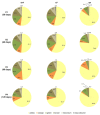Gastrointestinal Tolerance of an Infant Formula Manufactured from Extensively Hydrolysed Protein in Healthy Term Infants
- PMID: 37960327
- PMCID: PMC10647512
- DOI: 10.3390/nu15214674
Gastrointestinal Tolerance of an Infant Formula Manufactured from Extensively Hydrolysed Protein in Healthy Term Infants
Abstract
The evaluation of secondary parameters of a prospective, randomised, controlled, multicentre intervention trial aimed to analyse gastrointestinal tolerance of an infant formula manufactured from extensively hydrolysed whey protein (eHF) compared to intact cow's milk protein (control formula, CF) in healthy term infants. Infants ≤ 25 days of age, who were exclusively formula-fed, were randomised to receive eHF or CF for at least three months up to 120 days of age. An exclusively breastfed reference group (BF) was included for descriptive comparison. Infants' gastrointestinal tolerance was evaluated based on stool parameters, the Amsterdam Infant Stool Scale (AISS), the Infant Gastrointestinal Symptom Questionnaire (IGSQ), and sleeping patterns. Of 359 infants included, 297 randomised (eHF: n = 149, CF: n = 148) and 41 BF infants completed the study per protocol. All tolerance parameters were comparable between eHF and CF. Stool was predominantly soft and yellow in colour. Stool was more frequently green in eHF than CF. BF infants had more frequent stools, which were mainly watery or soft and yellow, and comparable IGSQ scores (descriptive). Irrespective of group, all gastrointestinal and sleep parameters showed signs of maturation with increasing age. In conclusion, eHF showed gastrointestinal tolerance as good as CF in healthy infants. Both formulae were well-tolerated.
Keywords: IGSQ; breastfed; digestibility; extensively hydrolysed whey protein; gastrointestinal tolerance; infant formula; infant nutrition; protein hydrolysate; sleeping; stool characteristics.
Conflict of interest statement
L.O., E.S., H.P., A.N., F.J. are employed by the Evangelisches Waldkrankenhaus Spandau, a nonprofit hospital. The department does paid research for different companies in the field of infant nutrition. The employer and F.J. have received support for scientific and educational activities by companies that market food products for infants. F.J. is a member of the Nutritional Committee of the German Society of Pediatrics (Deutsche Gesellschaft für Kinder- und Jugendmedizin (DGKJ)), which tends to be biased towards breastfeeding, and advisor of the German Hospital Association (Deutsche Krankenhaus Gesellschaft (DKG)). R.C., J.G., and A.G. are employed by Hipp GmbH & Co. Vertrieb KG.
Figures




Similar articles
-
Safety and Suitability of an Infant Formula Manufactured from Extensively Hydrolysed Protein in Healthy Term Infants.Nutrients. 2023 Apr 14;15(8):1901. doi: 10.3390/nu15081901. Nutrients. 2023. PMID: 37111119 Free PMC article. Clinical Trial.
-
Growth, Gastrointestinal Tolerance and Stool Characteristics of Healthy Term Infants Fed an Infant Formula Containing Hydrolyzed Whey Protein (63%) and Intact Casein (37%): A Randomized Clinical Trial.Nutrients. 2017 Nov 16;9(11):1254. doi: 10.3390/nu9111254. Nutrients. 2017. PMID: 29144393 Free PMC article. Clinical Trial.
-
The effect of a partially hydrolysed formula based on rice protein in the treatment of infants with cow's milk protein allergy.Pediatr Allergy Immunol. 2010 Jun;21(4 Pt 1):577-85. doi: 10.1111/j.1399-3038.2010.00991.x. Epub 2010 Mar 10. Pediatr Allergy Immunol. 2010. PMID: 20337976 Free PMC article. Clinical Trial.
-
Prevention of allergic disease in childhood: clinical and epidemiological aspects of primary and secondary allergy prevention.Pediatr Allergy Immunol. 2004 Jun;15 Suppl 16:4-5, 9-32. doi: 10.1111/j.1399-3038.2004.0148b.x. Pediatr Allergy Immunol. 2004. PMID: 15125698 Review.
-
Consensus statement on diagnosis, treatment and follow-up of cow's milk protein allergy among infants and children in Turkey.Turk J Pediatr. 2016;58(1):1-11. doi: 10.24953/turkjped.2016.01.001. Turk J Pediatr. 2016. PMID: 27922230
Cited by
-
Research Progress of Oral Immune Tolerance Mechanism Induced by Whey Protein.Nutrients. 2025 Apr 29;17(9):1517. doi: 10.3390/nu17091517. Nutrients. 2025. PMID: 40362825 Free PMC article. Review.
References
-
- Koletzko B., Godfrey K.M., Poston L., Szajewska H., van Goudoever J.B., de Waard M., Brands B., Grivell R.M., Deussen A.R., Dodd J.M., et al. Nutrition During Pregnancy, Lactation and Early Childhood and Its Implications for Maternal and Long-Term Child Health: The Early Nutrition Project Recommendations. Ann. Nutr. Metab. 2019;74:93–106. doi: 10.1159/000496471. - DOI - PMC - PubMed
-
- Iacono G., Merolla R., D’Amico D., Bonci E., Cavataio F., Di Prima L., Scalici C., Indinnimeo L., Averna M.R., Carroccio A., et al. Gastrointestinal Symptoms in Infancy: A Population-Based Prospective Study. Dig. Liver Dis. Off. J. Ital. Soc. Gastroenterol. Ital. Assoc. Study Liver. 2005;37:432–438. doi: 10.1016/j.dld.2005.01.009. - DOI - PubMed
Publication types
MeSH terms
Substances
LinkOut - more resources
Full Text Sources
Miscellaneous

